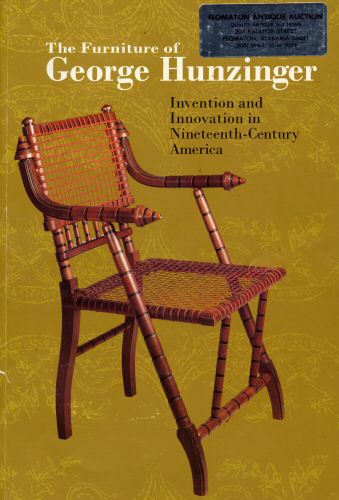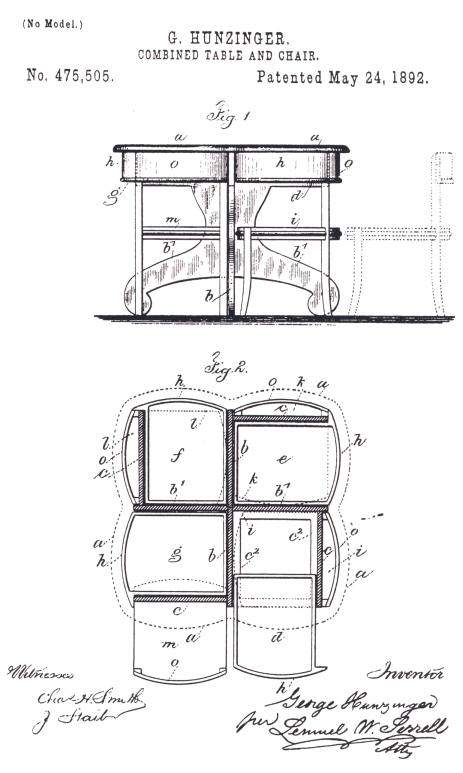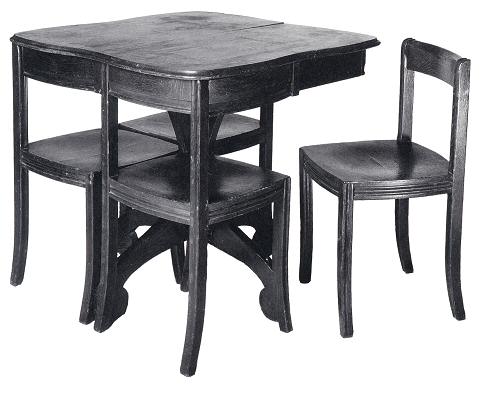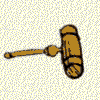|
|
|
|

In the January 2004 auction we had a number of Hunzinger
products.
We put together several book excerpts to describe the pieces we
had.
The following is reprinted with kind permission of The Brooklyn
Museum of Art.
Portions are reformatted for the web.

We
had the rocker version of the cover chair. Modularity was a Hunzinger
hallmark.
|
|
Fig. 92 George Hunzinger |
|
New Technologies: Woven Wire and Interchangeability
of Parts |
|
|
|
Fig. 35 |
|
|
|
Fig. 18 |
Hunzinger's spring mechanism and elaborate styling were unique.
|
|
The Furniture of George Hunzinger Note: This volume is no longer stocked by the Museum Bookstore. Check your favorite bookseller. |
|
|
Fig. 136 |
|
|
Fig. 141 |
|
The Platform Rocking Chair In 1882 Hunzinger secured a patent for a platform rocker that was to be his commercially most successful chair type (fig. 130). Hunzinger was not the inventor of the platform rocker and had, in fact, been making them since at least 1876 with a preexisting spring system. The platform rocker differs from more common rockers with runners by rocking in place on its own base with the help of springs. Americans seem to have been especially fond of the rocking chair, whereas Europeans associated the rocking chair with invalidism and infirmity. Traditional rocking chairs on runners tended to take up more room and make more noise than platform ones. They also tended to creep along the floor when in use. Experiments with platform rockers begain in the United States in the late 1860's. J. Wayland Kimball remarked in his often-cited catalogue: "Foreigners call the rocking chair a peculiarly American luxury, yet the necessary length of the rockers on the floor cause[s] this favorite chair to be occasionally in the way, and not infrequently too noisy for comfort. These disadvantages have been very ingeniously overcome in the chairs of certain makers who, in different ways, build them so that there is no rocker on the floor and the movements are always noiseless."... .....Hunzinger, then, was entering a well-established market for platform rocking chairs. The patent letter tells us that Hunzinger was well aware of the challenges of this form and the concerns of the consumer: Rocking-chairs have stationary bases for resting upon the floor have long been regular articles of manufacture; and said chairs have contained the springs and other devices in a number of forms to connect the stationary base and the rockin-chair to return from either end of its movement to a normal position. My invention relates to a device wherein the rockin-chair and stationary base are connected and held together by combination hinge and spring mechanism which insures a stable connection of the parts, and a the same time a positive and easy spring movement. A strip of feltlike textile was often applied to the upper surface of the stationary base to make the rocking movement smoother, and these chairs sometimes retain a paper label with the recommendation: "One drop of oil from your Sewing Machine can in every joint of hinge will prevent noise.".... |
|
|
|
Hunzinger Chairs in Nineteenth-Century Interiors The questions of who purchased Hunzinger chairs and how were they deployed in the houses of their original consumers are difficult to answer. Fortunately, a number of rare nineteenth-century photographs of interiors have survived that provide some answers. But, just as it is difficult to draw sound conclusions about how many Hunzinger chairs were produced in the nineteenth century from the number of a particular desgn that have survived today, so must one be careful about conclusions drawn from these valuable photographic documents. For example, the practice of making a photographic portrait of an interior was certainly common only among the house-proud upper classes. Therefore, one would expect to find higher-price Hunzinger chairs in such photographs. Also, one must take into account the date of the image. For example, a photograph taken in 1890 of an interior presumably decorated earlier that includes Hunzinger chairs made in 1870 might show the chairs reupholstered or deployed differently from the original arrangement. One of the first observations that can be made from these documentary photographs is that the Hunzinger chairs usually appear singly, as accent pieces, and not in large suites, although he did design coordinated suites, as discussed below. Chairs used in this manner were termed "fancy chairs" in the nineteenth century, and Hunzinger, in fact, referred to himself, on his letterhead (see fig. 13), in advertisements (se fig. 43), and store signage (see fig. 44) as a manufacturer of that form. |
|
FIG. 147 |
This chair was available with a variety of decorations.
|
|
|
|
|
Fig. 31 |
|
|
Fig. 23 |
We had two variations of this model.
|
.....The 1888 patent letter states: "Before my invention chairs had been manufactured with the posts or vertical slats of the back-frame and the horizontal rungs or rails united together by inserting the rungs into holes in the posts or slats and gluing the same, chairs of this character are not strong and reliable, especially in warm or moist climates, in which the glue is liable to become moist or soft or the wood to shrink." He continues: "By my improvements I am enabled to connect the various portions forming the back-frame or the arms, or both, in a very reliable manner without the use of glue and without weakening the strength of the wood work, as has heretofore been the case by the large holes made use of in connecting on part to the other." Hunzinger's simple but ingenious solution was to insert a continuous wire through, for example, the tops of the vertical elements of the back. The wires were threaded at either end and secured by decorative domed nuts that could be tightened as needed. This support could be used to connect the stretcher system below the chair as well. The problem of loose members in traditionally doweled and glued chair parts is, of course, an old one. Hunzinger's 1869 patented diagonal brace was also a response to this issue. Thonet had addressed this loosening and essentially solved it by the late 1860s by assembling his chairs with screws only. In the introductions to his catalogues, Thonet pointed out his solution and recommended the periodic tightening of the screws if the chairs became unsteady. Thonet's solution worked well because of the abbreviated nature of the designs of his chairs, which were composed of as few as six parts. Hunzinger's patent solved the problem for far more complicated designs.... .....Some of the chairs that incorporate the 1888 patent are more successful and show Hunzinger continuing his progressive exploration toward greater abstraction (figs. 153 and 154). The cube form, which was to be of increasing interest to chair designers around the turn of the century, can be traced to early nineteenth-century Regency designs. Hunzinger has reinterpreted this older design using only the sphere and attenuated dowels and constructed the chair with his patented, clueless wire system. Although the use of the sphere and dowels is abstract in the cube-shape chair, Hunzinger also sometimes flattened the spheres and carved a flower head into the center. Transforming the combination of sphere and dowel into a naturalistic flower and stem suddenly changes the pure geometry of the forms into a more conservative and literal interpretation (fig. 155). Hunzinger employed this U-shaped back composed of dowels and spheres on many forms, including chairs, platform rockers, and settees (figs. 156-158). The consumer could purchase a single chair, a rocker, or a settee, or combine any of these forms to create a unified suite of seating furniture. One wonders, however, how many "suites" were actually sold; Hunzinger seems to have more often positioned himself in the market as a maker of fancy chairs and relied on individual sales. |
|
|
|
FIG. 131 |
|
|
|
This is a chair and table set we had

|
Hunzinger's investigations of new forms and inventions, however, continued. In 1890 and 1892 Hunzinger secured two related patents for nesting chairs and tables (figs. 165 and 166). In the first patent, Hunzinger claimed: This invention relates to a table adapted to fancy articles or to games, and to chairs constructed so as to form part of the table when place beneath it, the tops of the chair-back forming the rim or base of the table-top, and the seats of the chairs forming shelves adapted for bric-a-brac or other articles, and such chairs when removed from beneath the table ar adapted for use as seats.... The table-top... is of any desired shape, preferably circular or elliptical....For small tables the chsir-bottoms will necessarily be small, and... I therefore make the seats so that it can be drawn forward away from the back legs, and this is conveniently accomplished by a central dove-tailed or rabbeted bar... for the convenience of the occupant. The second patent builds on the first. In the patent letter Hunzinger stated: The present invention is a improvement upon the device shown in Letters Pattent No. 433,623....And it is made with reference to the introduction into the table of drawers and fr providing chairs with rectangular seats instead of the trangular seat, ... rendering the table very compact and adapting the same to use in playing various games, because there is a drawer for each chair. In addition to the drawers, this patent also provided for chairs with larger seats and eliminated the need for the sliding mechanism beneath the seats in the first patent. |


| Page and photographs copyright 2004 by Neal Collier and Flomaton Antique Auction. Feel free to print these pages for personal use. Any commercial use of code or images is forbidden without permission. Hi-resolution images are available for license. |